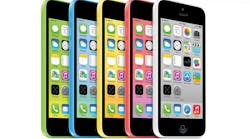Apple’s introduction of their budget iPhone 5C may have brought the use of plastic in cellphones to light for consumers, but the market is already a multibillion-dollar business that is only expected to increase. The market for molded plastic cellphone components is set to amount to $3.5 billion (USD) in 2013 and is then projected to reach $4.5 billion by 2017. Total plastic resin usage, in terms of weight, is set to increase to 336,000 metric tons in 2017, up from 282,000 metric tons in 2013.
Apple’s decision to use plastic for the 5C’s enclosure was driven in part by wanting to offer a lower-priced phone, but it also allows a wider range of colors to be produced (although the goldpagne version of the 5S is reportedly selling out faster than all other colors). With competition within the smartphone market rising, OEMs are seeking more and more ways to drive down costs for raw materials, manufacturing, and assembly while still increasing flexibility of design and strength; all of which the use of plastic provides. The most typically used plastic resin, acrylonitrile butadiene styrene (ABS), along with polycarbonate and ABS/polycarbonate blends, are used for everything from enclosures to mounting brackets, display frames, insulator sheets, and vibration cushions.
Another key factor in the increased usage of plastic is the adoption of low-end smartphones in emerging markets. It’s projected that more plastic will be used for a wide range of mechanical and optical components within the mobile handset and smartphone market; ABS and polycarbonate are expected to see a compound annual growth rate of 7% and 4.5%, respectively, through 2017. It’s not just cellphones, however that benefit from plastics. The use of plastics is becoming a major trend in the electronics industry as a whole including in LCD TVs, PCs, printers, media tablets, and even refrigerators, washing machines, and microwave ovens. It’s estimated that the electronics industry will consume nearly 16.0 million metric tons of plastics in 2017, up from 12.8 million in 2012.
It’s forecasted that 20 million iPhone 5Cs will be sold through the rest of 2013 and with each enclosure weighing 14.2 grams, 283 metric tons of polycarbonate resin will be consumed by one device in one quarter. It’s safe to say Apple is adding fuel to the metaphorical fire, but when you look at all the numbers, they definitely didn’t light the match.
